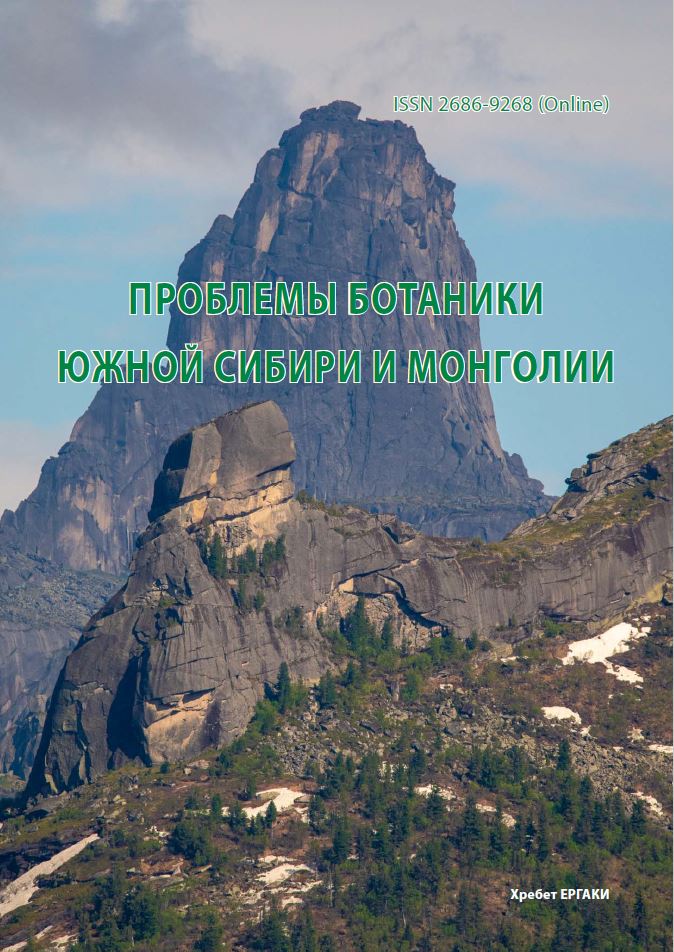Структура мезофилла листа и биомасса берез из разных природно-климатических зон Северной Евразии
УДК 581.1: 582.632.1
Аннотация
В условиях глобальных климатических изменений все более актуальной становится необходимость изучения адаптации лесообразующих видов, оценки их продуктивности и прогноза трансформации лесных экосистем. В данной работе представлены результаты анализа структуры мезофилла листа и биомассы деревьев в популяциях Betula pendula Roth и Betula pubescens Ehrh вдоль глобальной зонально-климатической трансекты, представляющей широтный ареал распространения этих видов в Северной Евразии. Показано, что при удалении от климатического оптимума в популяциях берез происходит уменьшение биологической продуктивности, а также структурная перестройка мезофилла листа, основанная на изменении размеров клеток и направленная на поддержание положительного углеродного баланса. Найдены высокие корреляции между размерами фото-синтетических клеток листа и биомассой ствола деревьев. Сделан вывод о том, что изменение размеров клеток мезофилла является ключевым механизмом структурной адаптации фотосинтеза к климату, определяющим продуктивность берез при смене условий роста. Размеры фотосинтетических клеток могут рассматриваться в качестве предикторов в прогностических моделях продуктивности лесообразующих видов и трансформации лесных экосистем под воздействием глобальных климатических флуктуаций.
Скачивания
Metrics
Литература
Анучин Н. П. Теория и практика организации лесного хозяйства. - Москва: Лесная пром-сть, 1977. - 176 с. Географический атлас / Под ред. Л. Н. Колосова. - Москва, Главное управление геодезии и картографии при СМ СССР, 1981. - 238 с.
Демиденко С. А. Объемы стволов березы в чистых березовых древостоях северной и средней подзон тайги Архангельской области // Вестник Поморского университета. Серия: естественные науки, 2011. - № 3. - С. 20-24.
Елсаков В. В., Марущак И. О. Тренды климатических изменений лесных фитоценозов западных склонов Приполярного Урала // Известия Самарского научного центра Российской академии наук, 2010. - Т. 12, №1(3). - C. 680-687.
Исаченко А. Г. Интенсивность функционирования и продуктивность геосистем // Известия Академии наук СССР. Серия географическая, 1990. - № 5. - C. 5-17.
Махнев А. К. Внутривидовая изменчивость и популяционная структура берез секции Albae и Nanae. -Москва: Изд-во «Наука», 1987. - 128 с.
Моисеев П. А., Шиятов С. Г., Григорьев А. А. Климатогенная динамика древесной растительности на верхнем пределе ее распространения на хребте Большой Таганай за последнее столетие. - Екатеринбург: изд-во УМЦ УПИ, 2016. - 136 с.
Earles J. M., Buckley T. N., Brodersen C. R., Busch F. A., Cano F. J., Choat B., Evans J. R., Farquhar G. D., Harwood R., Huynh M. et al. Embracing 3D complexity in leaf carbon-water exchange // Trends in Plant Science, 2019. -Vol. 24. -P. 15-24. DOI: 10.1016/j.tplants.2018.09.005
Ivanova L. A., Ivanov L. A., Ronzhina D. A., P’yankov V. I. Shading-induced changes in the leaf mesophyll of plants o different functional types // Russ. J. Plant Physiol., 2008. - Vol. 55. - P. 211-219. DOI: 10.1134/S1021443708020076 Ivanova L. A., Yudina P. K., Ronzhina D. A., Ivanov L. A., Holzel N. Quantitative mesophyll parameters rather than whole-leaf traits predict response of C3 steppe plants to aridity // New Phytologist, 2018. - Vol. 217, Iss. 2.- P. 558-570. DOI: 10.1111/nph.14840
Ivanova L. A., IvanovL. A., Ronzhina D. A., Yudina P. K., Migalina S. V., Shinehuu T., Tserenkhand G., Voronin P. Yu., Anenkhonov O., Bazha S. N., Gunin P. D. Leaf traits of C3- and C4-plants indicating climatic adaptation along a latitudinal gradient in Southern Siberia and Mongolia // Flora, 2019. - Vol. 254. - P. 122-134. DOI: 10.1016/j.flora.2018.10.008
Lehmeier C., Pajor R., Lundgren M. R., Mathers A., Sloan J., Bauch M., Mitchell A., Bellasio C., Green A., Bouyer D. et al. Cell density and airspace patterning in the leaf can be manipulated to increase leaf photosynthetic capacity // The Plant Journal, 2017. - Vol. 92. - P. 981-994. DOI: 10.1111/tpj.13727
Li Y., Reich P. B., Schmid B., Shrestha N., FengX., Lyu T., Maitner B. S., Xu X., Li Y., Zou D., Tan Z. -H., Su X., Tang, Z., Guo Q., FengX., Enquist B. J., WangZ. Leaf size of woody dicots predicts ecosystem primary productivity // Ecology Letters, 2020. - Vol. 23. - P. 1003-1013. DOI: 10.1111/ele.13503
Matsuura K., Willmott C. J. Terrestrial Air Temperature: 1900-2006 Gridded Monthly Time Series. Terrestrial Precipitation: 1900-2006 Gridded Monthly Time Series Ver. 1.01. 2007. URL: http://climate.geog.udel.edu/climate.
Migalina S. V., Ivanova L. A., Makhiev A. K. Size of the Leaf as a Marker of Birch Productivity at a Distance from the Climatic Optimum // Russian Journal of Plant Physiology, 2009. - Vol. 56, № 6. - P. 857-861. DOI: 10.1134/ S102144370906017X
Migalina S. V., Ivanova L. A., Makhnev A. K. Genetically Determined Volume of Mesophyll Cells of Birch Leaves as an Adaptation of the Photosynthetic Apparatus to Climate // Doklady Akademii Nauk, 2014. - Vol. 459, №. 6. - P. 765-768. DOI: 10.1134/S0012496614060106
Niinemets U., Portsmuth A., Truus L. Leaf structural and photosynthetic characteristics and biomass allocation to foliage in relation to foliar nitrogen content and tree size in three Betula species // Annals of Botany, 2002. - Vol. 89. -P. 191-204. DOI:10.1093/aob/mcf025, available online at www.aob.oupjournals.org.
Roddy A. B., Theroux-Rancourt G., Abbo T., Benedetti J. W., Brodersen C. R., Castro M., Castro S., Gilbride A. B., Jensen B., Jiang G.F., Perkins J. A., Perkins S. D., Loureiro J., Syed Z., Thompson R. A., Kuebbing S. E., Simonin K. A. The scaling of genome size and cell size limits maximum rates of photosynthesis with implications for ecological strategies // International J. of Plant Sciences, 2019. - Vol. 181, №1. - P. 3-33. DOI: 10.1086/706186
Ronzhina D. A., Ivanova L.A., Ivanov L. A. Leaf functional traits and biomass of wetland plants in forest and steppe zones // Russian Journal of Plant Physiology, 2019. - Vol. 66, №3. - P. 393-402. DOI: 10.1134/S1021443719030129
Terashima I., Shin-IchiM., Hanba Y. I. Why are sun leaves thicker than shade leaves? Consideration based on analyses of CO2 diffusion in the leaf // J. Plant Res., 2001. - Vol. 114. - P. 93-105. DOI: 10.1007/PL00013972
Weraduwage S. M., Chen J., Anozie F. C., Morales A., Weise S. E., Sharkey T. D. The relationship between leaf area growth and biomass accumulation in Arabidopsis thaliana // Frontiers in Plant Science, 2015. - Vol. 6. - P. 3-21. DOI: 10.3389/fpls.2015.00167



